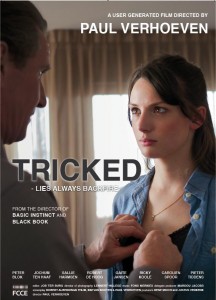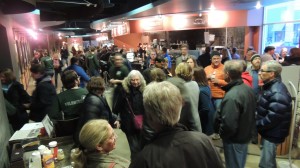This is part four of a five part series of suggestions for the 2015 Wisconsin Film Festival. As you’ve probably noticed, I decided not to squeeze all of the series in one week, which was not the greatest idea in the first place. I think these last two suggestions are worth thinking about, but I think it will be good to balance them with some posts about, you know, films. So I’ll leave the first three entries in the home page slider, and let people find their way to these last two parts if they remain interested.
If you haven’t done so already, please read at least the first half of part one as a reminder of everything the Wisconsin Film Festival does right and well. With that fresh in mind, I’ll proceed to today’s suggestion.
Suggestion #4: Improve the experience between screenings, even at the cost of the total number of screenings.
I’ve been privileged to wear many different hats at different Wisconsin Film Festivals over the years. My last significant direct role with the Festival was serving on the Wisconsin’s Own jury in 2011. This year I had a new hat, with a little “Press” tag tucked in the brim, as I covered the Festival for Isthmus and here at the Madison Film Forum. While I’ve spent a lot of time walking around during Festivals over the years, going from venue to venue, chatting with people along the way, this year was different because there were no short cuts to the experience. For the most part I didn’t use any “connections” to get in early or help secure a good seat (okay, I can think of an exception or two). I spent more time in the lines at the Wisconsin Film Festival this year than any other previous experience. So having walked a mile or two in patron’s shoes, I have two areas of concern: schedule flow, and between-screening experience.
 Eliminate Block Busters (Screenings In Between Programming Blocks)
Eliminate Block Busters (Screenings In Between Programming Blocks)
A working assumption for this suggestion is that the Festival is interested in audience flow from screening to screening, and would like audience members to be able to see as many films in a day as they can. If that is the case, then they need to eliminate screenings that occur between two blocks of programs. I addressed this in my “Mock Draft” schedule overview when I discussed how the screening of Tricked could either make or break your Saturday, because going to see it meant that you would miss 11 other screenings.
Everyone understands that at a film festival you can’t see everything, and that you have to make choices between films playing at the same time. But in most cases selecting any given film means that you can’t go to 6 other screenings (when there are 7 venues). Although I understand the impulse to maximize the number of screenings not only to generate revenue but also to increase the opportunities to see a given film, programming between major blocks of films, or staggering a film withing a block by more than an hour, undermines audience flow. It also undermines the Festival’s reputation for doing things the right way, and doing things well.
Jake Smith pointed out to me during the Festival that programmers did something similar with the programming of Jodie Mack: Let Your Light Shine. Strictly speaking, it was not scheduled between blocks, but it was the latest film in the fifth block on Saturday; while most of the films started between 5:30 to 6:30, Let Your Light Shine started at 7:00 pm. The consequence of this was very similar to the Tricked block busting, because 6 of the 8 films after Let Your Light Shine were impossibilities unless you made some kind of sacrifice. If one didn’t think that the Festival had buried its experimental programming into the backwaters of the Festival, it was hard not to think so after looking at the Saturday grid. I might understand the rationale for block busting with Tricked, because with the Verhoven name you will likely still get a healthy audience (and it did). But it is already challenging enough to cultivate audiences for experimental programming without this kind of scheduling. And audience members who seek a smooth programming flow to maximize the number of screenings that they can see are probably in the prime demographic for experimental programming.
Our favorite cine-couple, Larry and Dee Dee, had to make a sacrifice if they wanted to catch Jodie Mack: Let Your Light Shine and the Nick Cave film 20,000 Days on Earth. They made a much more adventurous decision than I did: Since Let Your Light Shine was a shorts program, they decided to skip some of the shorts to try to make it late to 20,000 Days on Earth. Larry and Dee Dee perfectly personify the target demographic for experimental programming (open minded, adventurous, and curious about everything), so why force them to make such a decision when they want to support as many Festival programs as possible, especially the ones outside the mainstream?
 Why do I feel like I’m already late for the next Sundance screening when I’m leaving a screening at Sundance?
Why do I feel like I’m already late for the next Sundance screening when I’m leaving a screening at Sundance?
Even though it is impossible to do (because there is work to be done), I highly recommend that the programmers at the Wisconsin Film Festival spend one day (or even an afternoon) simply waiting in the lines. When the doors open up, don’t go in, just go into another line. I think they will find their experience somewhat different than their experiences at other Festivals (I only have Sundance as a frame of reference). I think it will be an experience that they want to address and fix.
It was pointed out to me that there were an unusually high number of Theater Captains thanked in the Festival trailer, which could suggest that it was harder to find people to do multiple shifts or that more people were needed to compensate for a lack of experience. If the between-screening experience isn’t addressed, the Festival risks alienating not only patrons but their volunteer base as well. I stated in Suggestion #2 that I wasn’t going to say much about logistics, but I think it’s worth pointing out in this context a comment responding to Suggestion #2, from reader “Madgirl555”:
If the Festival wants to be [at] Sundance as a venue, please realize there are some pitfalls in scheduling stacked film start times […] It has gotten progressively stressful to be a volunteer at this venue. A Venue showing Three films at a time should be high on the list for organization not last to figure out because it doesn’t start on the first Thursday. It would behoove both teams to work together to make this venue shine, like I know it can. I use Sundance as my theatre of choice during the rest of the year. I don’t want to learn to avoid it during the Festival.
There’s a growing tension between the need to maximize the number of screenings (to generate much needed revenue) and the quality of the overall Festival experience. Note that Madgirl555 is not a “Sundance-hater,” she wants the venue to work well for the Festival. She doesn’t think it is working well, which is not a Sundance-specific problem. The problem is that not enough attention is being paid to the Festival experience between the films.
One Communication Arts professor (I mentioned him briefly in Suggestion #2, he said that he had seen people get dizzy in the Sundance lines) told me in passing that he felt like he didn’t have time to go to the bathroom between Sundance screenings. It seems like a small thing, but it’s not. I was tempted to title this article “[Professor’s name here] Must Decide: Relief or a Good Seat?”, but good sense prevailed. Still, I recommend that he add the point, “People need to go to the bathroom between screenings,” to the agenda of the next Wisconsin Film Festival meeting.
I’m against the “leave my coat” method of saving seats between screenings on many grounds (one being, the seat doesn’t “belong” to me just because I sat there once), so let’s assume that the Festival rightfully needs to clear the house between screenings. When you leave a screening, you realize that naturally a line has already formed for the next show, or is already being admitted for the next show in another theater. Now let’s assume that you’re not concerned about getting a “good seat” and are fine with simply getting a seat. You learn quickly in the Festival experience that even that can be difficult when travelling alone. When I did decide to sacrifice a “good seat” for just a seat by simply sitting down to rest in the lobby for a little while, I ended up in the front row. Fine, no problem, now I’ll go to the bathroom. But when I came back the woman sitting next to me said that she had to fight people to keep my seat, despite my coat being there.
One quickly learns, then, that even just to assure yourself seat, you have to adopt the swarm mentality of getting in line immediately, staying in line for 20 to 30 minutes, and staying in your seat once you’re in it.
Of course, no one is forcing you to do any of this. Another option would be to skip a screening to give yourself some breathing room. But does the Festival really want their target audience to start doing that?
To be fair, it is not immediately clear how this could be addressed easily, because increasing time between screenings would not necessarily solve the problem, and it potentially leads to a problem of generating revenue. And perhaps I haven’t sufficiently presented the case that there is in fact a problem here. If no one else feels this way about the between-screening experience, then the second half of this post can be ignored. But at the very least I would suggest that listen very carefully to feedback from volunteers like “Madgirl555” and the more Festival-engaged Communication Arts professors mentioned above as they think about what they want the overall Festival experience to be.
I want to address your point about thanking so many theater captains, which I number among. We have more volunteers sign up than we could ever need, and have to cap the number of people we allow to volunteer. We captains are experienced volunteers that offer much more of our time than the average volunteer (I put in over 40 hours at Sundance each of the last two years) and the fact that there are so many like me thoroughly rebuts your theory.
I agree with many of your points about spacing screenings, but the fact is any time a theater sits empty is lost revenue. My personal goal as a volunteer has always been to get the greatest number of people to see the greatest number of films humanly possible. We have addressed both of these issues with festival passes for those patrons that really want to jump from screening to screening, available for $300, and you can easily get your money’s worth out of them
Victor,
Thanks for another perspective on the matter. In that point I made at the end of last year’s Festival I was drawing on my observations as a programmer in the early days of the Festival as a point of comparison, especially the first years that the Festival expanded off-campus.
I’m not sure if we’re really so far off from each other here. I think we both agree that the Festival would be impossible without experienced theater captains who come back year after year.
Thanks for your ongoing work, and I’m sure we will see you next month!
Jim K.